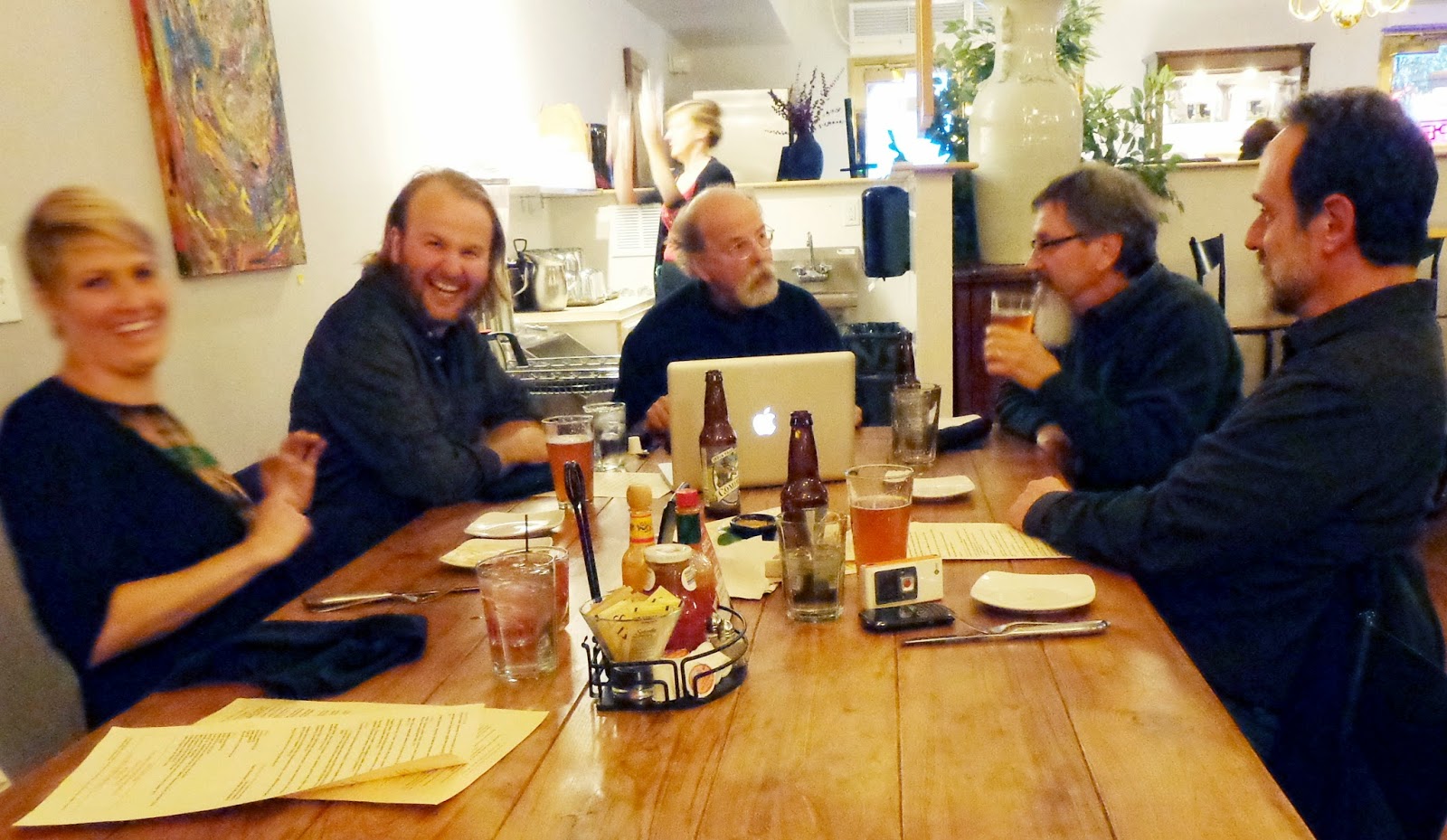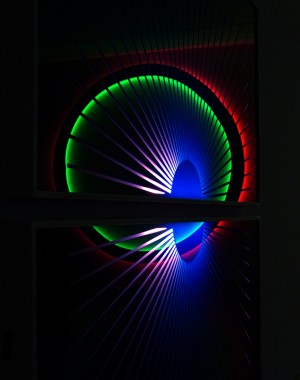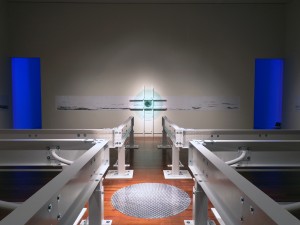h: Charles Parson
Co: Collin Parson
S: Sean O’Meallie
J: Joy Armstrong
B: Blake Milteer
S: The conversation we’re having right now comes from a fine tradition. So much great art and many stories have come from people like us gathering and just having conversations and throwing out ideas and having little tugs of war and then responding by going back to their studios and making new work.
Ch: In the spirit of Black Mountain College in North Carolina years ago, and like the cultural luminaries of the mid-20th century, we’re hungry for the dialogue. To me, this hasn’t been just about the orchestration of putting a show up, it’s been a dialogue in which the conversations we’ve had during studio visits and correspondence have continued on a much deeper level — at times even absurdly humorous when we’re doing heavy lifting during installation!
J: Chuck has referred to the exhibition as a “punctuation” — not in the sense of being the end of any particular activity — but rather being a comma in the progression of the artist’s work.
S: Maybe that’s especially true when, as with this exhibition, a lot of the work is built for the first time in the gallery space — so it only takes its first breath in that setting. When I’m doing a large project, I can’t stage it in my studio. Often times, the first time I see it is when it is afforded by a large enough venue. I recently put up a piece and was ecstatic and I just ran around the gallery saying “I can’t believe it worked!” But for you guys, both of these works are the first time you’ve seen them. But have you even really seen your pieces yet?
Ch: Hell no! I’ll recall a moment that will shed some “light” as it were: Collin was about 10 days ahead of me in the installation process due to the sheer nature of our extended responsibilities — our daytime jobs, individual installation requirements, and other expectations. So I walked in and saw that he had finished the first phase of getting his work up. His gallery was already inspiring dialogue after that first week of installation, and I went home very despondent because I couldn’t yet see what mine was going to actually look like. I was suddenly concerned; it wasn’t insecurity, but I was creatively questioning whether my installation was going to be as good as I thought it was supposed to be. That’s unsettling!
Co: Blake, you called that, though. Remember when I got my exhibition up, and you said, “your Dad’s gonna walk in and be proud but immediately start thinking about his piece — how am I going to get it up?” You called it! But I think that comes from getting to know the artist over the past few years.
B: At best, it’s important for these exhibitions to gestate over a number of years. When you get to that point of installation, the process and the relationships become all the more intensive, as it should be. You want to be able to anticipate certain things, some of them from a professional level and some of them from an intuitive level — both of which can only be developed over that duration. Part of it is that you’re going to have those inevitable “uh oh!” moments even right before the opening and everyone has to have the tools and trust to conjure greatness in spite of adversity.
S: There are so many unknowns and so many variables — for artists making the work and for all the people who put up risk. I think everybody here put up risk and took a chance — there’s no way to exactly know the outcome. Like in theatre, you don’t quite know how it’s all going to come together until dress rehearsal. It’s a live thing, an organic thing, and that’s really nice to have, I think, as a gift from the institutional provider — to trust artists. To choose and trust an artist — it’s like describing a balloon, when you don’t quite know the exact shape of the balloon.
J: I think Sean’s theatre comparison is really great. It’s that idea of being able to develop the relationship to the point where you’re comfortable and you trust the people that you’re working with. So when it comes to opening night, it’s not so over-rehearsed that it feels stale. There’s room for spontaneity and room for improvisation because it’s not 100% planned out, giving you the flexibility to play.
S: It’s live.
Ch: I love that confidence; it’s got to be there if we’re going to take chances.
Co: I think in his career, (Chuck’s) been around so long that it’s easier to trust an artist of his age (laughs), or of his experience, compared to an artist of my experience. But I think that when you guys came to visit me at Pirate (Contemporary Art gallery, Denver) over and over and over, I would hope you started to have a confidence and trust, right?
J: Blake mentioned intuition, and for me with you, that was there from the beginning. There was never any doubt that you’d be able to do it.
B: All the right ingredients are there, so that trust is in place. With Continuance, that was tested by some big alterations in course along the way with changes in the schedule and in the gallery spaces.
Ch: Looking back now, I like the idea that we had to adapt our definition of the show. Thinking about evolution of the space and the conditions, I remember talking with my friend Fred Ramey about (Olivier) Messiaen, the composer. In a German concentration camp, he wrote a piece of music, “Quartet for the End of Time.” I think it’s one of the most stunning pieces of music ever written and recorded. But it’s written for a violin with three strings because that’s all they had. What he pulled out of those three strings made what he was attempting to say in the piece of music so much more direct and poignant. So what does this present (as an analogy to the exhibition)? It’s that we have to be more attuned to what we’re trying to say and deal with it creatively. What most people would say is …
Co: “… Can’t do it!”
Ch: Yeah, “can’t do it,” and you then (settle for) a more conventional solution like just putting up an existing body of work. Instead, it’s a great opportunity to develop another body of work by extending the timeline a little and articulating the space.
B: Some of the specific changes were that we had to push the show back a year at one point, and had to pretty dramatically change the gallery spaces for each of you.
Co: I originally had the lower ceiling gallery, so I would have never been able to do the 16-foot diameter signature piece in the show.
S: And is this your largest piece?
Co: To date, yeah.
S: Wow. I really like that you responded to that opportunity. You saw that you could hike up the scale on this thing. Chuck’s piece is also site-specific. That came to you while in the space, is that right? That’s how you conceived it, in that space?
Ch: Yes. The theme was already developing, but to have the space in that specific room, my first comment to Blake was “I wanna use the (18-foot-high) ceiling by putting nothing up there above human height.” His comment was, “yeah, that’s pretty interesting, let’s explore it.”
S: The negative space?
Ch: Yes, but it’s not just the negative space — it’s that absence. That is what I’m intrigued with in a controlled interior space as opposed to the works I build at a particular exterior location.
S: I think you are both after something quite ephemeral. Whether you intend to or not, it’s a result. Collin’s work is quite atmospheric; it’s light in material and lofted on the wall and enveloping — completely enveloping. It alters the space in an obvious, quickly understood way, while Chuck’s work seems to have this great gravity of material. For me, the apparatus goes away when we’re within the spaces of your work. How important is that to you? Is that something you’re thinking about from the get-go, or is that a product you just discover? Is the apparatus — or the departure from it — the most important thing in the room?
Ch: You’re talking about form and content. You’re talking about that essential attempt to visually enunciate. The read on Collin’s work, and I don’t mean this in a dismissive way, is that there is an immediacy to his work. It’s not just the color, it’s not just the scale, it’s the cycles that are perceived quickly. Mine is the absolute opposite in terms of my attempt to slow time down; it’s as if Collin’s is ice melting and we can watch it melting before our eyes on a hot day. Mine is like marble that is dissolving but over a longer duration of time. There’s an immediacy to his work and there’s a denseness to my work. At times I envy the initial quick response that people give his work, but I realize that the driving forces in my work are the apparatus, the language of the materials, the use of the room, even the title of the work. It’s like when you listen to music and you don’t hear the instruments, you don’t hear the notes. You hear the music. That takes time in the music and it takes time in my art.
Co: When you mean apparatus, it’s the mechanism, right?
S: All the things that take up physical space.
Co: Then I would say yes, I create the apparatus as a mechanism to support the light. If I had my ultimate world, you’d go in there and experience an environment of thick light that you can grab and eat it like an apple. But you can’t do that, because you need these mechanisms. I create an apparatus but it’s less about the object than what (it’s) helping to convey.
Ch: There is light spillover from Collin’s gallery through the portals on each side of my work. When I sat there late on a Sunday night during installation I could see no object in Collin’s gallery, just the sheer light. Then suddenly the light turned a faint turquoise and for a split second echoed (the green tinted plexi) I just spent all day putting up. The joy of interaction! You can’t touch it but that feeling conjured up an awareness of the moment. That moment, for me, is ultimately what I’m looking for in art.
S: Discovering art, happening upon art when you least expect it — it’s a momentary thing, it’s something that you can’t choreograph, it’s something that you just stumble into and realize that you’ve just felt something. Collin’s work pushes and pulls on that a little bit because of the slow cycles of color changes.
Ch: The color transitions are perceptible but not predictable. There’s a harmonic rhythm to it.
S: There is a kind of pulsation in your work.
Co: That’s why I use light. It’s not like, say, a red canvas on the wall; light can make that red feel different, feel more alive. I love light — it has a quality that is unknown, but you sense it.
S: Light permeates us — we’re ambient beings. I can make an object but it doesn’t penetrate your body. It registers with your vision and sense of touch, but it doesn’t emit. I think light reaches us in other ways.
S: Backing up to the making of the art itself, here’s something that sticks with me: Carl Reed is one of the longtime instructors here at Colorado College, and he’s a wonderful artist. His work will make you reconsider all of the objects in your world and their relationship to one another. I remember one time on an art discussion panel, Carl said, “good art just needs to happen. It’s not dependent on — should not be dependent on — any kind of other processes; it just needs to happen.” I’m paraphrasing, but this is one of the more truthful things to me as an artist who is putting work in front of people and taking earthly resources and committing them to this kind of intent. I thought it was a very good thing to hear, and a good observation that good art just needs to happen, regardless of the process it takes for it to happen.
Ch: I love reading Walt Whitman’s Leaves of Grass. He self-published it seven different times before it was picked up. I mean, that pretty-well says that if it needs to be done, do it. I have a protestant work ethic. If it’s that important, you’ll find a way as an artist. The challenge is to make some concessions in materials or in scale, but not to the art’s intention and merit.
Art doesn’t always need a huge audience. I’ll give you a quick illustration: my two sons and I had just installed a work next to the Brooklyn Bridge. We were going to drop-off my truck and trailer at aunt Jean’s house on Long Island, and between she and her husband we could not get clear directions. The truck was pretty big and the trailer was even longer so we parked it in their little suburban neighborhood with meandering little single-lane roads. I knew their house was somewhere nearby, so we (went) walking and suddenly heard Jean’s voice singing. Now this is a woman who had in a previous year performed at the Kennedy Center as a soloist; this is a woman who had just had major public television specials done on her 40th album. We rounded a bend, walked up a little drive, and then figured out we’d come in the back way. She’s on the back porch with no audience except a cat and she is singing for the sheer joy of singing! That’s Carl Reed, in essence, saying it’s gotta be made.
S: There’s that old question of who you make your art for — why do you make art? To be honest, I make art so that I can see it. I need to get something out of me, I need it to be out there in the room and I need it to talk back. So I’m the first audience for the things that I make. For me as a maker, that “live” art moment is when I get the thing up in front of me and I can confront it physically, frontally. That’s the moment when I have to consider it and have to start living with it. I get to respond to it and I’m working in a syntax and a language that is all my own; it’s very unique, but I am the first person who encounters it.
Co: I think that’s not unusual.
S: That’s actually as sincere as I can be. I’m getting something out of me and I have to then live with it and respond to it. Now, one of the wonderful things that happens is that other people respond to it too, in ways that I could never anticipate. So (the art) has a life beyond that moment.
Another aspect is that when I make something, I am also confronted by the idea that it didn’t exist until I made it.
Ch: There’s great satisfaction in making. But then you put ideas — the concept — into (the art). I’ve had times when I’m getting ready to go to bed after supper and I’m so curious about an idea that I go out to the studio in my underwear and find myself two hours later, shivering and still working on something.
Co: It’s a physical need.
Ch: An issue I ran into in academia is that the idea of art as being heroic is obsolete. Well, I think making art is a very heroic activity in today’s culture!
S: And noble.
This artist discussion is an excerpt from the Continuance catalog, available for purchase at Alice’s. Food. Art. Coffee.




